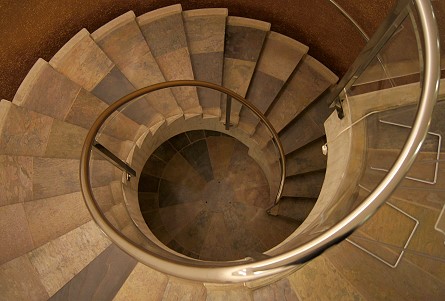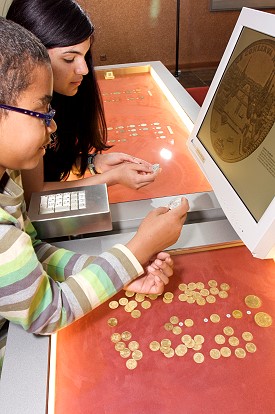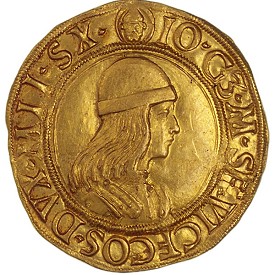PANTA RHEI – “everything flows.” This quote from the work of the Greek philosopher Heraclitus perfectly encapsulates everything the Money Museum strives to be – always changing, never resting on the laurels of its past, and always remaining in the lead when it comes to the challenge of seeking out new forms of communication.
This is why the MoneyMuseum is selling a tiny but valuable portion of its collection. The proceeds will go towards financing a brand new chapter of the MoneyMuseum: a multimedia presence on iTunes University.
A debut on the Internet
It all began with 500 coins privately amassed Dr. Jürg Conzett. Leo Mildenberg oversaw the collection right until his death, which is one of the reasons for the outstanding quality of the Greek coinage, in particular.
 But the owner of this collection travelled so often, he barely had a chance to hold the coins in his own hands – for Jürg Conzett, the Internet offered a solution. He put his collection on the Net at moneymuseum.com, both for himself and for anyone who might be interested in it. In April 1999 the MoneyMuseum went online, and interest did indeed prove great, since at the time, although perhaps hard to imagine today, it was the first institution to make a large volume of coin photos available on the Internet.
But the owner of this collection travelled so often, he barely had a chance to hold the coins in his own hands – for Jürg Conzett, the Internet offered a solution. He put his collection on the Net at moneymuseum.com, both for himself and for anyone who might be interested in it. In April 1999 the MoneyMuseum went online, and interest did indeed prove great, since at the time, although perhaps hard to imagine today, it was the first institution to make a large volume of coin photos available on the Internet.
Today, the MoneyMuseum has 2,600 coins in its possession. In terms of numbers, it cannot compete with the large institutions, of course, but it’s not the number of objects that interests Jürg Conzett.
Instead, the aim of his MoneyMuseum is to make visitors think about money – about its history, but also about its future. For this reason, there are no conventional, traditional types of coin exhibits. The focus here is on the issues and questions raised by our past. An exhibit about gambling may well finish with a station where visitors have to vote on whether gambling on the stock market can in fact be considered “gambling.” And the exhibition projected for 2014, “The Fair Price – Economic Thinking in the Middle Ages,” will almost certainly have something to say about globalization and bonuses as well.
The Sunflower Foundation
Since June 1999, the Sunflower Foundation – also started by Dr. Jürg Conzett – has been responsible for presenting the MoneyMuseum’s collection. But this founder and current head of the MoneyMuseum actually comes from a completely different background to what you might expect. He completed his degree in history and psychology at the University of Zurich in 1972 and then went on to graduate from the prestigious School of Management at Stanford University. He worked as a financial analyst in New York, Tokyo and Zurich. His constant dealings with money piqued his curiosity as to the relationship between man and money – to what extent has money influenced our history? And to what extent does it continue to exert its influence today? And how should money look in the future in order to be able to bring about a better, more humane and just economy?
 These questions are reflected in the objectives set by the Sunflower Foundation:
These questions are reflected in the objectives set by the Sunflower Foundation:
1.) To present the history of Western money from its beginnings right through to the middle of the 20th century, using the latest techniques and a superior quality coin collection.
2.) To display alternatives to our society’s currently accepted money model.
3.) To promote an open and relaxed approach to the topic of money.
From a virtual to a real museum
The MoneyMuseum is a dynamic project that is constantly changing and evolving. Everything is temporary and in flux. And so, by the year 2000, the virtual Internet MoneyMuseum opened its first real branch on the premises of the Swiss National Museum. In 2002, the MoneyMuseum opened its first proper permanent exhibition on the history of money in Zurich in the museum on Bärengasse, a branch museum of the Swiss National Museum. In February 2003, the MoneyMuseum was inaugurated on Hadlaubstraße. And come 2014, everything will be changing yet again when the museum on Hadlaubstraße undergoes renovations.
Discussion Forum and Platform
One thing, however, will remain the same – the MoneyMuseum’s focus always remains on the big picture. The ultimate aim is to offer visitors food for thought about their own relationships with money. And to do so, the MoneyMuseum has always pursued new methods of conveying this information, be it through audio dramatizations, DVD presentations or films. Everything is geared towards the layperson as well, not just numismatic connoisseurs.
Part and parcel of this as well are the unconventional contexts in which the MoneyMuseum places money – the well attended lectures include themes as diverse as “money in literature,” “money in psychiatry and psychotherapy” all the way to “your money personality – your writing.” There are historical lectures too, of course, but the history serves not as an end in and of itself, but rather a backdrop against which the present must be compared.
Social Responsibility and Cyclos
Just being a museum and a platform isn’t enough for the MoneyMuseum. Very much in keeping with humanistic ideals, Dr. Jürg Conzett’s knowledge and experience have led to a commitment to develop alternatives to the current monetary economy. The MoneyLab provides information on complementary monetary systems and exchange platforms. The open source software “Cyclos” allows for online management of complementary monetary systems. The MoneyMuseum has been instrumental in providing the software to German speaking countries.
The MoneyForum
The MoneyMuseum stands for innovation. And true innovation requires a change in thinking, at upper levels as well. To this end, the MoneyForum offers an opportunity for exchange between high-ranking theorists and influential practitioners. It is a forum in which the “decision makers” acquaint themselves with what is happening and why. In doing so, it hopes to promote a balance of interests and, in the long-term, also initiate policy changes.
The Only Constant is Change
In order to expand its reach beyond just Zurich, the MoneyMuseum wants to strengthen its role as a discussion platform on the Internet. Experienced speakers from the MoneyForum and the MoneyMuseum will be offering podcasts on current hot money topics, but also insights into the history of money. The MoneyMuseum will have a presence on iTunes University in German and English, with many shorter and longer sequences about coins, money, economic history, economics, but also about alternatives and the future of money – all of it intended for a wide audience, and everything available for free download at any time from anywhere in the world. The sale of the coins will go to partially finance this project.
The employees of the MoneyMuseum are looking forward to this new challenge; since if there’s one thing that always remains the same there, it’s that everything is always changing, always in flux.
The MoneyMuseum is selling pieces from its collection to help finance its presence on iTunes University
The MoneyMuseum is selling some of the precious items from its collection. The money raised won’t be going to ongoing maintenance, however, but rather to financing an innovative new project: The MoneyMuseum will be presenting podcasts on iTunes University on topics from the world of money.
 The MoneyMuseum has a new project. It will be presenting a series of both short and more comprehensive podcasts on iTunes University on the topics of coins, money, economic history, economics and banks and stock markets. Of course, these podcasts will also touch on themes like alternatives to the current prevailing monetary system and the future of money. The past will also figure prominently: Podcasts featuring numismatic content will also regularly be available for download.
The MoneyMuseum has a new project. It will be presenting a series of both short and more comprehensive podcasts on iTunes University on the topics of coins, money, economic history, economics and banks and stock markets. Of course, these podcasts will also touch on themes like alternatives to the current prevailing monetary system and the future of money. The past will also figure prominently: Podcasts featuring numismatic content will also regularly be available for download.
In order to realize this mammoth project, Dr. Jürg Conzett, founder of the Sunflower Foundation and director of the MoneyMuseum, has decided to auction off a tiny but valuable portion of the museum’s own collection. The pieces consist of the finest quality Greek coins, for the most part, whose selection is owing not just to the collector, Jürg Conzett, but also most notably to Leo Mildenberg. The widely known numismatist and coin dealer oversaw the coin collection of the MoneyMuseum until his death in 2001.
With his trained eye, Mildenberg procured outstanding pieces for the MoneyMuseum – with respect to style and condition. As a result, some examples from the collection include what may be considered the finest known specimens, as is the case with the tetradrachm from Catane, purchased at Bank Leu 71 (1997), No. 50. The same is true for a fine tetradrachm from Leontini, acquired in the same year at the first auction of the then newly founded company Triton, in New York.
 The true highlight of the coins that will be offered for sale, however, are three coins from Syracuse: 1.) A tetradrachm of the Demareteion series, extremely fine, wonderfully struck and centered; 2.) A dekadrachm of exquisite beauty signed by Euainetos, whose avers displays none of the usual traces of rust from the die; and 3.) A tetradrachm featuring the rare design of Arethusa, the hair gathered under a folded hood. The Museum of Ancient Art Basel’s 1988 catalogue, page 128, offers the following about this type of coin: “The monumental, serious head is unique among the array of early classical Arethusa heads. Its master – who, apart from this piece, is undetectable in Syracuse – combines increased physicality, expressed here in the folds of the hood, with a new sense of spatial positioning.”
The true highlight of the coins that will be offered for sale, however, are three coins from Syracuse: 1.) A tetradrachm of the Demareteion series, extremely fine, wonderfully struck and centered; 2.) A dekadrachm of exquisite beauty signed by Euainetos, whose avers displays none of the usual traces of rust from the die; and 3.) A tetradrachm featuring the rare design of Arethusa, the hair gathered under a folded hood. The Museum of Ancient Art Basel’s 1988 catalogue, page 128, offers the following about this type of coin: “The monumental, serious head is unique among the array of early classical Arethusa heads. Its master – who, apart from this piece, is undetectable in Syracuse – combines increased physicality, expressed here in the folds of the hood, with a new sense of spatial positioning.”
Also of outstanding beauty is the Zeus head on the stater of Elis, purchased at Sotheby’s in 1998. It has featured in both the Lambros collection as well as that of Sir H. Weber and R. Jameson. From the Trampitsch collections comes a stater of the Parisii. It is among the most splendid representatives of these early precursors of abstract art.
These are just some of the examples of the coins that the MoneyMuseum will be selling in order to finance its newest project. International auction house Numismatica Ars Classica will act as partner for the sales. The ancient coins will be coming up for auction on May 16th and 17th, 2013 in Zurich. The Italian coins will be offered in the fall auction.
You can learn more about the auctions online at www.arsclassicacoins.com.
Additional information about the MoneyMuseum as well as the complete collection can be found at www.moneymuseum.com. You can also use or download many of the MoneyMuseum’s products on the Sunflower Foundation / Media site, at: http://www.sunflower.ch/index.php?p=media_home
1 Catane (Sicily). Tetradrachm. From Bank Leu auction 71 (1997), 50.
2 Leontini (Sicily). Tetradrachm. From Triton auction I (1997), 257.
3 Syracuse (Sicily). Tetradrachm of the Demareteion series. From Bank Leu auction 76 (1999), 54.
4 Syracuse (Sicily). Tetradrachm. From NAC auction 13 (1998), 447.
5 Syracuse (Sicily). Dekadrachm, signed by Euainetos. From Naville-Ars Classica auction 13 (1928), 342 and NAC 13 (1998), 481.
6 Elis. Stater. From the Lambros collections; Sir H. Weber and Jameson. From Sotheby auction (December 1998), 24.
7 Ptolemy I (Egypt). Tetradrachm. From Bank Leu auction 71 (1997), 243.
8 Gian Galeazzo Maria Sforza of Milan. Double ducat. From Bank Leu auction 68 (1996), 359.




